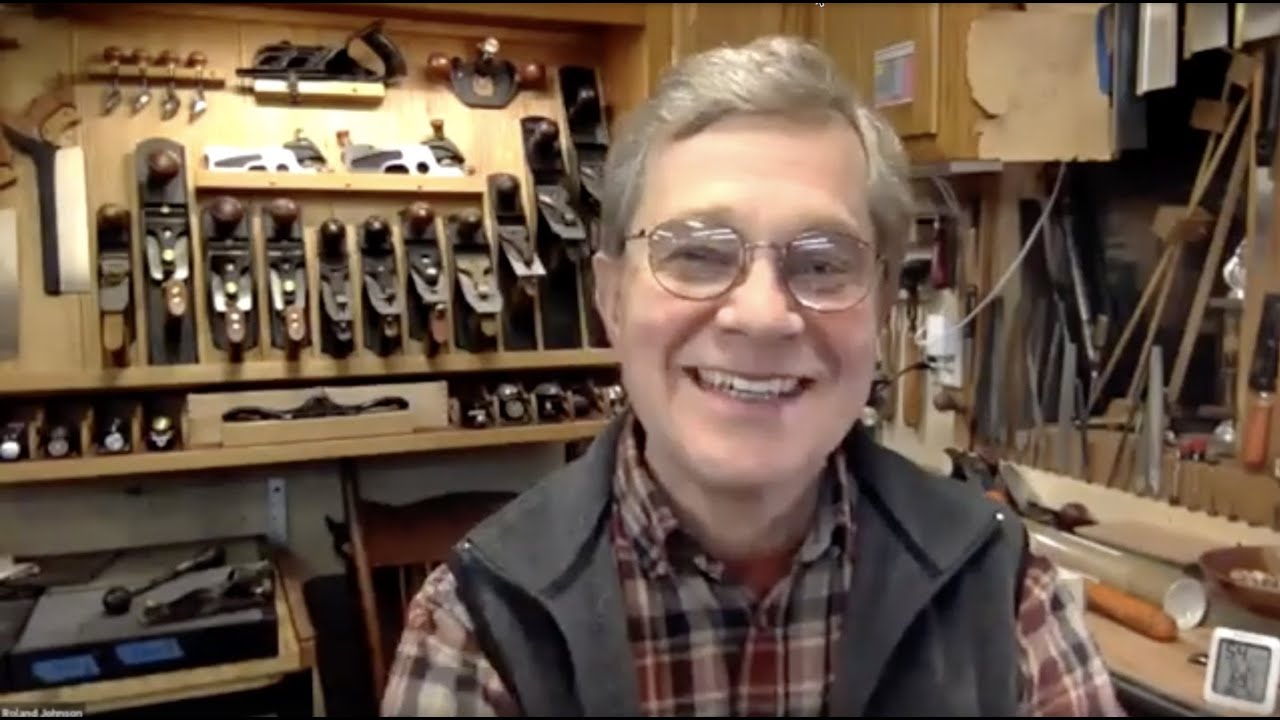“Coloring Wood” but this isn’t an hour on chemical reactions of gasses, dyes and stains. It’s more holistic. Before you start a project give serious color consideration to the woods. There are so many factors to consider: e.g. grain texture, wood color gradations, how wood color ages, etc. Test coloring assumptions and coloring techniques on scrap before you even start. He promotes thinking about color at every stage and learning coloring just like you would any woodworking technique.
A 20-year veteran of Fine Woodworking, we were happy to have him present.
| 00:32:37 | Gloria: | would it be possible for me to record this? |
|---|---|---|
| 00:37:32 | Travis: | It is being recorded |
| 00:38:20 | Gloria: | thank you |
| 00:38:53 | Gloria: | would it be possible for me to attain a copy of the recording after the presentation today? |
| 00:45:37 | Jered Greenwald: | confirming that email was editor@sdfwa.org ? |
| 00:47:05 | Michael: | yes that is the correct email address |
| 00:47:16 | Jered Greenwald: | thanks! |
| 00:47:37 | Travis: | Yes, Jered … editor@sdfwa.org |
| 00:53:12 | Lewis H: | Awesome! I was hoping for a turning class! |
| 00:53:59 | Jan J: | turning class would be so awesome 
|
| 00:54:50 | Avis: | Would love to learn how to turn! |
| 00:56:04 | Avis: | And the sale is in person? |
| 00:56:51 | Peter Tobias: | Is there a downloadable flyer that we can print up for our friends/neighbors? |
| 00:58:32 | Gloria: | thank you |
| 01:00:59 | Nels: | Jim I missed that. Can you put it in the comments please? |
| 01:01:07 | Lou Newell: | how were door prize winners seleted? |
| 01:03:36 | Jeff Levin: | FWIW, connectivity issues can be minimized if most of us blank our video feeds. |
| 01:04:24 | Travis: | The sale will be in person unless COVID prevents that. We have safety protocols and a backup plan of doing the sale online. |
| 01:04:47 | Travis: | Lou, I’ll ask Jim to answer about door prize process. |
| 01:07:41 | Travis: | The file is an electronic flyer of the Holiday Gift Sale you can use to share with friends. |
| 01:07:43 | Gary Anderson: | We do have a downloadable “save the date” flier for the Holiday Gift Sale. We also have “Save the Date” business card size handouts available at the Shop |
| 01:08:16 | Travis: | https://sdfwa.org/hgs/ |
| 01:08:25 | Travis: | The flyer is also on the website. |
| 01:23:55 | jeremy winter: | poke a hole in the lid first!!! |
| 01:28:00 | Jered Greenwald: | Like to Ebonizing article in Fine Woodworkinghttps://www.finewoodworking.com/2019/03/27/ebonizing-wood-2 |
| 01:28:04 | Jered Greenwald: | Ebonizing Wood - FineWoodworking |
| 01:56:45 | Tom Schulz: | https://www.amazon.com/Adventures-Wood-Finishing-Charonne-Woodworking/dp/091880406X |
| 01:57:15 | Paul Schankin: | Rabbit-skin glue - Wikipedia |
| 02:00:35 | Mike Reidy: | lb/gallon=oz/cup |
| 02:02:09 | Woodworker’s Guild of Rhode Island: | Adventures in Wood Finishing is a great read! |
| 02:03:24 | Paul Williamson: | High-proof Everclear isn’t available in California AFAIK. |
| 02:04:17 | Paul Duffield: | I have a lot of success with 99% Isopropyl alcohol |
| 02:04:20 | Kim: | I suspect the extremely pure isopropyl alcohol we can get will work similarly |
| 02:05:08 | Paul Schankin: | It is legal to sell Everclear 190 in Alabama, Arizona, |
| 02:13:31 | Jerry Aarestad (SDWT): | Roland, please comment on light fastness of stains and dyes |
| 02:13:33 | Paul Duffield: | Roland. Thank you for a truly outstanding presentation. I learned some very good ways to improve my finishing. |
| 02:13:52 | Paul Schankin: | can you bottle up your knowledge in a bottle and sell some? |
| 02:14:14 | Kevin Deal: | pat edwards sell the rabbit skin glue. ready to use |
| 02:14:33 | Lou Newell: | Thank you for a great presentation!! |
| 02:14:45 | Paul Duffield: | My question is that we are not able to getreal mineral spirits here in CA. Have you ever used citrus solvent as an alternative? |
| 02:16:36 | Michael mcelhiney: | I have been able to buy denatured alcohol using Amazon Prime. |
| 02:17:07 | Dick’s iPad: | Thanks for a truly informative presentation. Are you familiar with Pawlonia? I am making hollow wooden surfboards with it because of it low weight and high strength to weight ratio. It is consider a “closed cell” species and I wonder how it would take stains/dyes? |
| 02:17:12 | Paul Schankin: | well done! |
| 02:17:49 | Rory Geil: | Great information, thank you |
| 02:18:07 | Joe Fleming: | What are your choices for applying finish? What types of sprayers, brushes, rags, etc? |
| 02:18:34 | Jane Hastings: | Have you tried staining or dying eucalyptus? |
| 02:19:42 | Tim Miley: | for coloring with dye what is your favorite wood for custom furniture? |
| 02:20:13 | Tim Miley: | also have you used conversion varnish |
| 02:20:13 | Scott Patrick Murphy: | So you don’t recommend water based dyes? |
| 02:20:17 | Paul Schankin: | https://www.waterlox.com/ |
| 02:23:46 | walt groves: | What about Liberon Tung oil? |
| 02:33:10 | Kim: | Thank you for a great presentation. |
| 02:34:49 | Rick VanHatten: | Very concise. Thank you |
| 02:34:50 | Paul Schankin: | thank you |

